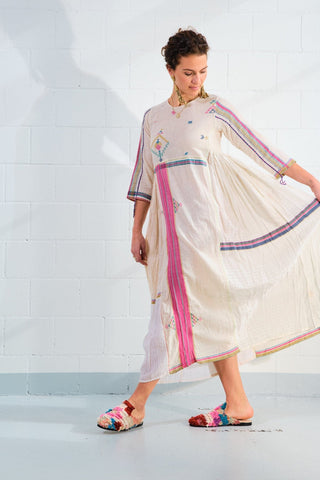Taan-Baan for Injiri is about the strength of the yarn on the loom and the sound produced by the weaver
Chinar Farooqui’s slow fashion label is a poetic ode to the indigenous textiles and crafts of India. Back in the 18th century, the people of Nigeria called the Madras plaid fabric exported from South India, ‘Injiri’ which basically translated to ‘from India’ - etching the perfect back story to the name of this soulful brand and make it so typically to be a really By Adushka Brand.
“The key thought has been to sustain relationships with the same weavers over the years. The three crafts are pillars of what Injiri stands for. We have been working with all three for the last ten years and it is very important for us to provide work to these weavers and standing by the technique every season helps in doing so,” shared Chinar.
‘Taan Baan’ draws a parallel between Indian classical music and traditional Indian textiles. In the language of Indian Classical Music, ‘taan’ refers to the rapid melodic vocal technique in raga singing. ‘Baan’ is another word for thread, a bow, and a derivation for the weft. A derivation of ‘baan’ is ‘bani’, which also means language. Together ‘Taan Baan’ for Injiri is all of the above—the strength of the yarn on the loom unyielding and as well as the language of the loom, a song that is set to the rhythm of weaving, the sound produced by the weaver to create his wonders.”It is important to understand that Injiri designs without altering symbols of craft but builds with it new essays.
In other words, by not changing the language of the loom, we are creating within the traditional sphere to retain the geographical mark of the place the tradition comes from. In Indian classical music, you are taught the basic notes and one can improvise and change the permutations and combinations to create music.
Similarly in traditional Indian textiles once you understand the basics of that specific craft (which is specific to that regional practice and technique) you can improvise.
Textiles in India are region specific —for instance, an ikkatpractised in Orissa follows a certain methodology, and the ikkat practised in Andhra follows another technique—making each unique. To innovate in textiles, we have to innovate within the given constraints which are the know-how and essentially human heritage, that has been passed down for generations. Also, just as music is learnt from a guru, so too is traditional textile techniques learnt from people who have been practising the art for generations,” added Chinar explaining the intriguing concept further.
HANDMADE AND UNIQUE
The bright and vibrant colours are the USP of Injiri, for ‘Taan Baan’ the designer has explored the clamp dyeing technique by the Khatri weavers. Popularly known as the tie-dye method, dyeing is a resist dye technique where folding and clamping helps in retaining some parts of the fabric from receiving that colour. This is repeated several times until the fabric has the desired pattern of three to four colours on it. Clamps were originally used by traditional artisans in Gujarat.
The collection is influenced by artist Mark Rothko’s paintings and the Mughal-era Jama, Chinar further describes how she found a sweet spot between these contrasting sources of inspiration. “Both influences are different from each other and may not necessarily come from the same idea. Both have their place in the way we look at craft, history, and design. A Mughal Jama is something that speaks of history, human heritage, craftsmanship and luxury. A Mark Rothko painting is inspiring for its beautiful use of colour and proportions. Both are inspirations that have a deep impact in their own way.
By Adushka Styling Tips: Lola Hats handmade in Brooklyn New York, Woyoyo handcrafted wood bags from Georgia, Calla handmade babouches from Marrakesh… or our loved The Jacksons handmade Jute Bags.
































